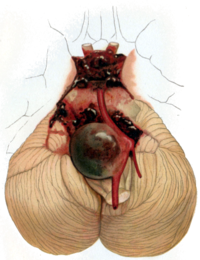
Photo from wikipedia
To study the vessel wall imaging characteristics of non-saccular aneurysms on high resolution magnetic resonance images. A review of a prospective aneurysm database at our institution was performed to identify… Click to show full abstract
To study the vessel wall imaging characteristics of non-saccular aneurysms on high resolution magnetic resonance images. A review of a prospective aneurysm database at our institution was performed to identify all consecutive patients with intracranial non-saccular aneurysms with vessel wall imaging. Patients were divided into two groups: 1) those with stable aneurysms and 2) those with growing/unstable aneurysms. Clinical and radiographic characteristics including mural enhancement and intrinsic high T1 signal were compared between the two groups using Fisher’s exact test and students t-test. All images were reviewed by two independent neuroradiologists with a senior neuroradiologist resolving discrepancies. Twenty-four non-saccular aneurysms in 22 consecutive patients with more than 12-month-follow-up were included (mean follow-up=37 months). Seven aneurysms (29.2%) grew and 17 (70.8%) were stable or regressed. AWT1H was detected in 20.8% (5/24) aneurysms, while AWE was detected in 95.8% (23/24) aneurysms. There was substantial to excellent inter-reader agreement for the assessment of aneurysmal wall T1 hyper-intensity (AWT1H) (κ=0.92), and of aneurysmal wall enhancement (AWE) (κ=0.65). Growing non-saccular aneurysms were significantly more likely to have intrinsic AWT1H (71.4%) than aneurysms which were stable (0, p Disclosures Y. Fang: None. W. Brinjikji: None. I. Radovanovic: None. J. Byun: None. D. Mandell: None. T. Krings: None. V. Pereira: None.
Journal Title: Journal of NeuroInterventional Surgery
Year Published: 2018
Link to full text (if available)
Share on Social Media: Sign Up to like & get
recommendations!